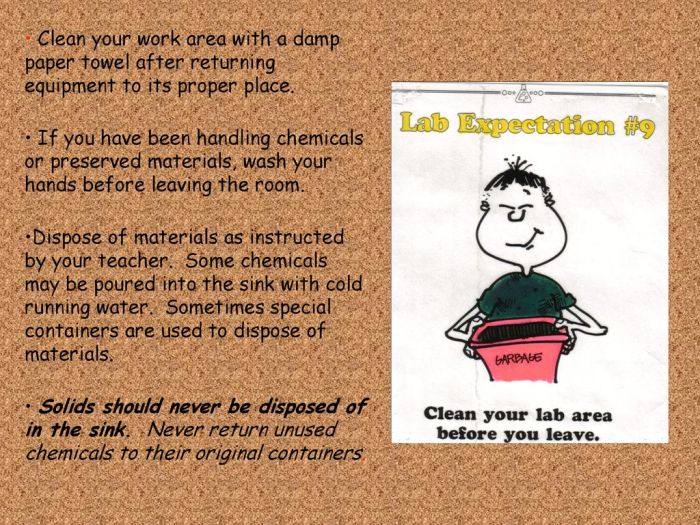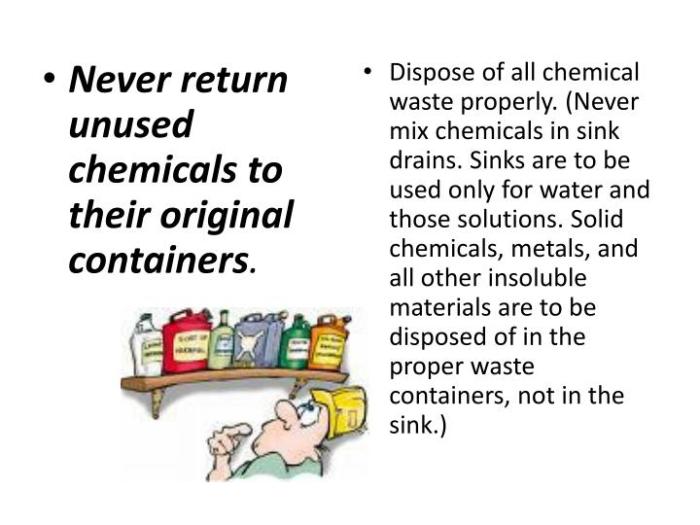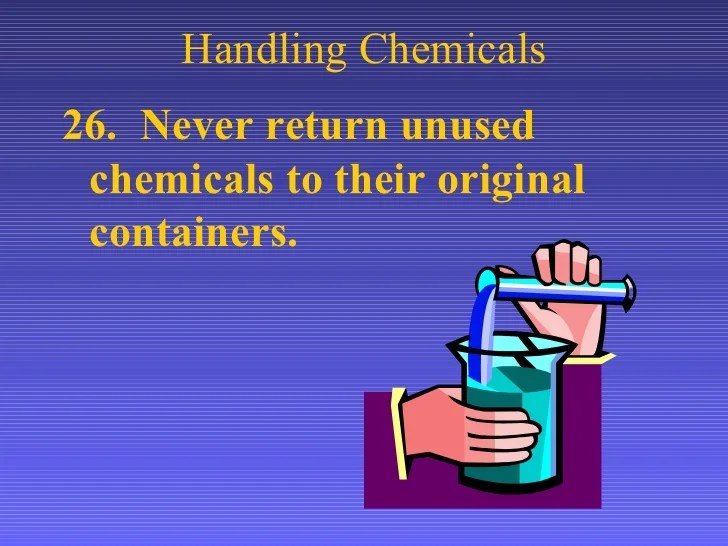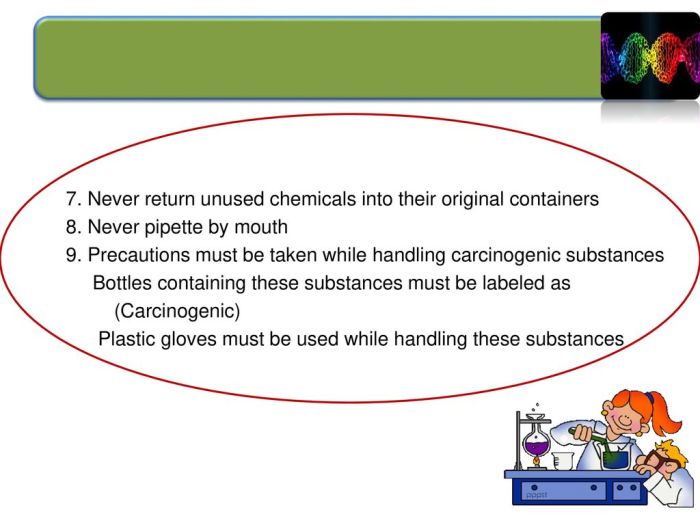Never return unused chemicals to their original containers – Never returning unused chemicals to their original containers is a crucial practice in ensuring workplace safety and environmental protection. This practice demands attention to the potential hazards, proper disposal methods, and regulatory compliance associated with chemical handling and storage. Understanding the risks and adhering to best practices are essential for mitigating accidents and safeguarding human health and the environment.
Improper chemical storage can lead to dangerous reactions, fires, and explosions. Mixing incompatible chemicals can release toxic fumes or cause violent reactions. It is imperative to understand chemical compatibility and stability to prevent such incidents.
Potential Consequences of Returning Unused Chemicals to Original Containers

Returning unused chemicals to their original containers poses significant hazards and risks. Improper storage can lead to dangerous chemical reactions, spills, fires, and explosions. For instance, mixing incompatible chemicals can release toxic gases or create unstable compounds. Additionally, improper storage can compromise the integrity of the container, leading to leaks and contamination of the environment.
Elaborate on the potential hazards and risks associated with this practice.
- Chemical reactions: Incompatible chemicals can react violently, releasing toxic gases or creating unstable compounds.
- Spills: Leaking containers can cause spills, contaminating work surfaces, equipment, and the environment.
- Fires: Flammable chemicals can ignite if improperly stored, leading to fires and explosions.
- Explosions: Unstable compounds or mixtures can explode, causing severe injuries or fatalities.
- Environmental contamination: Improper disposal can release chemicals into the environment, harming ecosystems and human health.
Provide specific examples of accidents or incidents that have occurred due to improper chemical storage.
- In 2015, a chemical plant in China exploded due to improper storage of flammable chemicals, killing 173 people.
- In 2019, a laboratory fire at a university in the United States was caused by the improper storage of chemicals in a refrigerator.
- In 2020, a chemical spill at a manufacturing facility in India contaminated a nearby river, killing thousands of fish.
Explain the importance of proper disposal and handling procedures for unused chemicals.
Proper disposal and handling of unused chemicals is crucial to minimize risks and protect human health and the environment. This involves identifying and segregating incompatible chemicals, using appropriate containers and storage conditions, and following established protocols for disposal.
Understanding Chemical Compatibility and Stability
Chemical compatibility refers to the ability of two or more chemicals to be safely stored or mixed without reacting dangerously. Understanding chemical compatibility is essential for safe chemical storage and handling.
Discuss the concept of chemical compatibility and its significance in chemical storage.
Chemical compatibility is determined by the chemical properties of the substances involved. Incompatible chemicals can react violently, release toxic gases, or form unstable compounds. It is important to consult compatibility charts or consult with experts to determine the compatibility of different chemicals.
Explain how mixing incompatible chemicals can lead to dangerous reactions.
- Acid-base reactions: Mixing acids and bases can generate heat, release toxic gases, and form corrosive solutions.
- Redox reactions: Mixing oxidizing and reducing agents can release energy, creating sparks or explosions.
- Polymerization reactions: Mixing certain chemicals can initiate uncontrolled polymerization, releasing heat and potentially causing explosions.
Provide examples of incompatible chemical combinations and their potential consequences., Never return unused chemicals to their original containers
- Acids and bases: Mixing hydrochloric acid and sodium hydroxide produces a corrosive solution that can cause severe burns.
- Oxidizers and fuels: Mixing hydrogen peroxide and acetone can create an explosive mixture.
- Acetylene and copper: Acetylene reacts with copper to form copper acetylide, which is highly explosive.
Alternative Methods for Disposal of Unused Chemicals

There are several methods for safely disposing of unused chemicals, including waste collection services, chemical waste disposal facilities, and neutralization and treatment processes.
Describe different methods for safely disposing of unused chemicals, including:
- Waste collection services: Many municipalities offer hazardous waste collection services for residents and businesses.
- Chemical waste disposal facilities: Specialized facilities are available to dispose of large quantities of hazardous chemicals.
- Neutralization and treatment processes: Certain chemicals can be neutralized or treated to make them less hazardous before disposal.
Explain the advantages and disadvantages of each method.
| Method | Advantages | Disadvantages |
|---|---|---|
| Waste collection services | Convenient, accessible | Limited capacity, may not accept all chemicals |
| Chemical waste disposal facilities | Professional handling, large capacity | Expensive, may require transportation |
| Neutralization and treatment processes | Reduces hazards, allows for on-site disposal | May not be suitable for all chemicals, requires expertise |
Best Practices for Chemical Storage and Handling

Proper storage and handling of chemicals are essential to minimize risks. This includes using appropriate containers, labeling, and storage conditions, as well as using safety equipment and personal protective gear.
Provide guidelines for proper storage and handling of chemicals to minimize risks.
- Use appropriate containers: Chemicals should be stored in compatible containers that are designed for the specific chemical.
- Label containers clearly: All chemical containers should be clearly labeled with the chemical name, hazards, and handling instructions.
- Store chemicals properly: Chemicals should be stored in a cool, dry, and well-ventilated area away from incompatible materials.
- Use safety equipment: When handling chemicals, appropriate safety equipment such as gloves, goggles, and respirators should be worn.
- OSHA’s Hazard Communication Standard (HCS): Requires employers to provide information about hazardous chemicals to workers, including labeling, safety data sheets, and training.
- EPA’s Resource Conservation and Recovery Act (RCRA): Regulates the generation, storage, and disposal of hazardous waste, including chemicals.
Discuss the importance of using appropriate containers, labeling, and storage conditions.
Using appropriate containers ensures the integrity of the chemical and prevents leaks or spills. Clear labeling helps identify the chemical and its hazards, while proper storage conditions minimize the risk of reactions or decomposition.
Explain the role of safety equipment and personal protective gear in chemical handling.
Safety equipment and personal protective gear protect individuals from exposure to hazardous chemicals. Gloves prevent skin contact, goggles protect eyes from splashes, and respirators prevent inhalation of toxic fumes.
Regulatory Compliance and Safety Protocols: Never Return Unused Chemicals To Their Original Containers

Regulatory requirements and industry standards related to chemical storage and disposal ensure workplace safety and environmental protection.
Explain the regulatory requirements and industry standards related to chemical storage and disposal.
Regulatory requirements and industry standards vary by jurisdiction but typically include guidelines for chemical storage, labeling, handling, and disposal. These regulations aim to minimize risks to human health and the environment.
Discuss the importance of adhering to these regulations to ensure workplace safety and environmental protection.
Adhering to regulations and safety protocols is crucial to prevent accidents, protect workers and the public, and minimize environmental impact. Non-compliance can result in fines, legal liability, and damage to reputation.
Provide examples of specific regulations and their implications for chemical handling practices.
Helpful Answers
What are the potential consequences of returning unused chemicals to their original containers?
Returning unused chemicals to their original containers can lead to dangerous reactions, fires, explosions, and contamination. Mixing incompatible chemicals can release toxic fumes or cause violent reactions.
How can I safely dispose of unused chemicals?
There are various methods for safely disposing of unused chemicals, including waste collection services, chemical waste disposal facilities, and neutralization and treatment processes. The appropriate method depends on the specific chemicals involved.
What are the regulatory requirements for chemical storage and disposal?
Regulatory requirements vary depending on the jurisdiction. However, common requirements include proper labeling, storage in appropriate containers, and adherence to safety protocols. Failure to comply with regulations can result in fines, legal liability, and environmental damage.